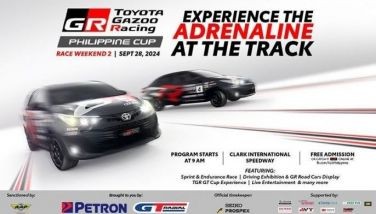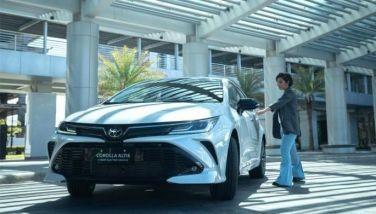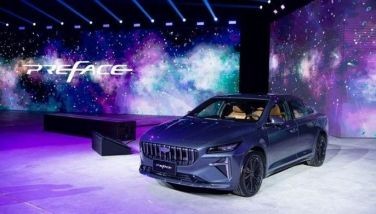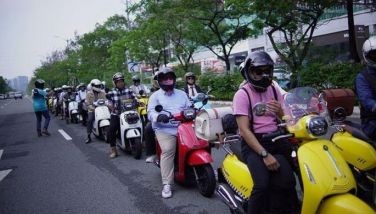Rotundas vs U-turns
Two schools of thought regarding which traffic infrastructure can best address the metro’s traffic flow problems appear to be coming to a head—rotundas as against U-turn slots.
Latest reports have it that the Quezon City government, through Mayor Herbert Bautista has called on the Metropolitan Manila Development Authority (MMDA) to dismantle a newly constructed rotunda, which is now being observed to cause more traffic congestion than when it wasn’t there before. This development is in the midst of announced plans of MMDA chairman Francis Tolentino to build more roundabouts in the metro to ensure a continuous flow of traffic, in place of some of the U-turn slots put up for the same purpose by the past MMDA administration under then chairman Bayani Fernando.
Based on my experiences and observations in some of my few travels abroad, I cannot dare say that one traffic infrastructure is better than the other—that U-turns can better ensure a smoother traffic flow over rotundas or the other way around. I think they have their own specific use for a specific road network or design.
Take the case of U-turn slots prevalently being used in many thoroughfares from Bangkok to out-of-the-city destinations in Thailand. Seldom can one come across an intersection that would allow vehicles from one side of the highway to cross to the other that could cause the disruption of traffic flow. Instead, vehicles wanting to cross to the other side must first join the traffic flow on the highway and after a ‘safe distance’ can change lanes and safely get into a sizeable U-turn slot and again join the flow of vehicles going the other direction until they make their turn.
The whale of a difference between the U-turn slots in Metro Manila compared to those found in Thailand is that those we have here are way too near to the supposed intersection that was closed that vehicles that just made a U-turn have a few meters to spare to change lanes and make their turn. And that’s when the problem starts and that’s when accidents begin to happen. We can perhaps deduce that U-turn slots work better on longer and wider roads, which are quite rare here.
I dare make Thailand as my example despite their being known presently as a country having traffic problems because in my more than a dozen trips to the Kingdom starting from more than a decade ago, I have seen how they have successfully turned around their then-much more chaotic traffic problem (the joke then was that a hostile neighboring country always had two thoughts about invading Thailand because of their fear of getting stuck in Bangkok traffic) to a much more manageable one presently.
Now rotundas or runabouts in Europe are a common sight. They have one in almost all intersections in most European countries. However, you would notice that rotundas in big cities where there are more vehicles are still being controlled by a system of traffic lights and traffic infrastructures like small traffic islands to guide motorists. But those in smaller towns with lighter vehicle traffic have more free-flowing roundabouts that are not controlled by traffic lights. However, motorists are well-informed and highly-knowledgeable about rules of right-of-way that seldom would you find traffic flow problems. But then rotundas in Europe, especially those with a maze of feeder roads are huge in size, which again is not a prospect in our present road network in Metro Manila.
Having said that, maybe both rotundas and U-turn slots would not optimally work in Metro Manila. They may work in some very few places (maybe, but I’m not even sure) but as a “go to” solution to ultimately solve the metro’s traffic flow problem may be far-fetched.
But before we dig deep to find a solution to the problem, we must first do a lot shoveling and analyzing to find out its causes. We don’t need a huge backhoe or an Einstein to do that—we simply have to look around and find too many automobiles in Metro Manila traveling in a very limited road network. Of course the problem is further exacerbated by uninformed and undisciplined drivers.
No, we can’t just line up all these driving scumbags against the wall and shoot all of them. That’s going to be very messy. And definitely we cannot stop people from buying automobiles. That’s going to be counter-productive for a country that’s has a rapidly developing auto industry.
Then the solution is to have more roads—perhaps on top of existing ones.
There was one time I was invited to go to Japan. On our way to Tokyo we made a stopover in one of the small cities. The traffic in the city was light but then I noticed newly finished, solidly concreted pillars lining the roads. When I asked our hosts what they were for, I was told they were for the construction of an overhead road. When I asked what for—when there wasn’t much traffic to speak of—I was told that they expect increased traffic due to huge development that would start in three years. Now, that’s thinking ahead.
But I guess it’s not that late for us, especially if building more roads is the only solution to our traffic woes. Should we decide to start, there would definitely be inconveniences and discomfort for all motorists. But then it’s a sacrifice for our children and theirs. It’s not gonna be for us. It’s for them.
Let’s bite the bullet.
The all-new Toyota Camry has arrived
Well, it was really hot and humid for a summer day launch but when our friends from Toyota beckon, it’s not that hard to disregard the uncomfortable weather.
Toyota Motor Philippines (TMP) unveiled the all-new Camry last Thursday, April 26 at the Sofitel, first to the motoring media during lunch and to its dealers and friends of Toyota later in the evening.
For those of our readers who are curious to know what the all-new Camry has to offer, it features a 3.5-Liter V-Type, 6-Cylinder, 24-Valve Dual VVT-i engine which provides a maximum output of 204kW/6,200rpm, and maximum torque of 346Nm/4,700rpm. The chassis system is highlighted by the 6-speed sequential automatic transmission now available for all variants. This transmission technology is supposed to let ample power pass more efficiently to the wheels, while the sequential shift lever lets the driver enjoy manual transmission-like drive. The most suitable gear is selected according to the driving condition, resulting in a pleasant driving experience. It is also fitted with a 16-inch front disc brakes, and 15-inch disc for the rear, to prove better stopping power. It’s also matched with redesigned 215/55R 17-inch alloy wheels to give the all-new Camry a more dynamic look.
For safety, the Camry features ABS and Brake Assist System, coupled with Vehicle Stability Control (VSC) technology. The VSC detects tire slippage and automatically helps stabilize the car when driving on slippery roads. Adaptive Front Lighting System (AFS) enhances nighttime visibility by automatically regulating the headlamp beam pattern in response to steering input and driving conditions. Driver and passenger SRS Airbags are offered across all variants, with the addition of side and curtain-shield airbags for the top-of-the-line 3.5Q model.
There are more to discover in the all-new Camry, which we would like you to do yourself by visiting any of TMP dealers nationwide.
BMW 5 Series for visiting dignitaries
Starting today until Saturday, May 5 all the distinguished visiting Heads of State and dignitaries attending the 45th ADB Annual Governors’ Meeting at the PICC shall be chauffeured from their hotels to the meeting’s venue and anywhere else they want to go aboard a fleet of the remarkable BMW 5 Series. Asian Carmakers Corporation (ACC), the official importer and distributor of BMW automobiles in the Philippines, is the official premium mobility sponsor as the country hosts its biggest economic event this year.
“ACC is honored to be an integral part of the 45th ADB Annual Governors’ Meeting. We salute the ADB and the Philippine government in their efforts to address social economic issues and seek comprehensive solutions for its member countries. We are in full support of this mission by providing the utmost level of mobility comfort, safety and security during their stay,” said Maricar Parco, the lovely president of ACC.
“BMW is recognized as a preferred mobility provider around the world and has been instrumental in delivering superior mobility and service for significant gatherings globally including social, governmental and regional events. The BMW 5 Series has a solid reputation around the world in terms of performance, fuel efficiency, and safety. There simply is no other choice for these types of international events,” added Glen Dasig, ACC executive director for sales and marketing.
ACC prides itself as being the undisputed leader in the Philippines’ premium luxury segment for almost a decade. To ensure the security of the delegates, ACC will also provide the drivers who have gone through rigorous trainings on security to ensure that only the utmost quality of service and hospitality will be experienced by the heads of delegations during their stay in the country.
To all the delegates, do enjoy riding in comfort, luxury and style.
Happy Motoring!
For comments: (e-mail) [email protected]
- Latest






























